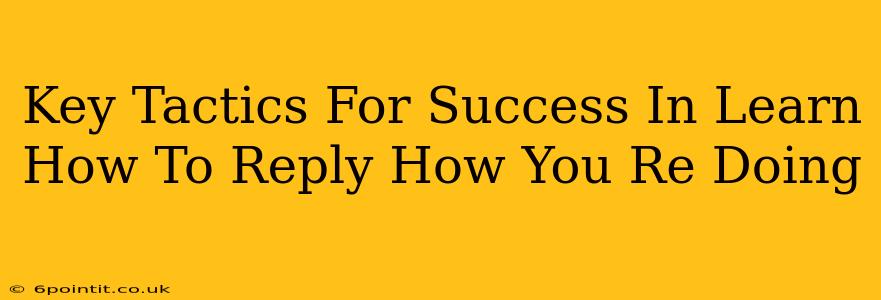Knowing how to respond to "How you doing?" might seem simple, but mastering a reply that fits the context and your relationship with the speaker is key to successful social interactions. This seemingly simple question opens a door to deeper connections or awkward silences, depending on your response. This guide will explore key tactics to navigate this common social exchange effectively.
Understanding the Nuances of "How You Doing?"
Before diving into responses, it's crucial to understand that "How you doing?" isn't always a literal inquiry about your well-being. Its meaning can vary dramatically based on:
- Context: A casual greeting among friends differs greatly from a formal meeting.
- Relationship: Your response to a close friend will differ from your response to a coworker or a stranger.
- Tone: A playful tone necessitates a different reply than a serious or formal one.
Identifying the Underlying Intent
Consider the speaker's body language and tone. Are they genuinely interested in your day, or is it a simple greeting? This discernment is key to crafting an appropriate response.
Crafting the Perfect Reply: Tactics for Success
Here are several effective tactics to tailor your response to different situations:
1. The Simple & Sweet Approach
For casual settings and acquaintances, a simple and positive response works wonders:
- "I'm doing great, thanks! How about you?" This is classic, polite, and encourages reciprocal conversation.
- "Pretty good, thanks! And yourself?" A slightly more informal yet still friendly option.
- "Good, thanks! How's it going?" Concise, positive, and engaging.
These options are versatile and appropriate for most everyday encounters.
2. The Detailed & Engaging Response
If the context allows for more detail (close friends, family), you can elaborate:
- "I'm doing well, thanks! Just finished [activity] and feeling good about [achievement]." Shares specifics and positive emotions.
- "Things are pretty hectic, but good hectic! Working on [project] and it's keeping me busy." Honest yet still positive, shows you are engaged in life.
- "I'm doing okay, but could use a little [positive thing]. How's your week going?" Shows vulnerability while remaining positive and prompting further conversation.
3. The Professional & Concise Reply
In professional settings, keep it brief and professional:
- "I'm doing well, thank you. How are you?" Formal, polite, and suitable for the workplace.
- "Good, thank you. And yourself?" Concise and appropriate for a quick exchange.
- "Fine, thank you." A perfectly acceptable formal response when brevity is essential.
4. Handling Negative Situations Gracefully
If you're having a rough day, it's okay to be honest (within reason):
- "I'm having a bit of a rough day, but I'm pushing through." Honest yet shows resilience.
- "Not so great, but hopefully things will improve." Acknowledges negativity without dwelling on it.
- "I'm a little overwhelmed at the moment, but thanks for asking." Keeps it brief while being truthful. Avoid excessive complaining.
Remember to always follow up with a question directed back at the person who asked, showing interest in their well-being as well.
Beyond the Words: Nonverbal Communication Matters
Your body language and tone significantly influence the impact of your response. Maintain eye contact, smile genuinely, and use a positive and engaging tone of voice.
Conclusion: Mastering the Art of Reply
Mastering the art of replying to "How you doing?" is about understanding context, tailoring your response to the situation, and using both verbal and nonverbal cues effectively. By applying these tactics, you can transform a simple greeting into an opportunity to connect meaningfully with others. Practice makes perfect; the more you engage in social situations, the more natural and confident your responses will become.

